Holland America Line - MV Noordam 1938
& Westerdam 1946 - Passenger-Cargo Liners
Please Note: Firefox and some other search
engines are not suitable – Use “Internet
Explorer” for this page to load
perfectly!

Click the logo above to
reach the ssMaritime FrontPage for News Updates & “Ship of the Month”
With Reuben Goossens
Maritime
Historian, Cruise‘n’Ship Reviewer, Author & Lecturer
Please Note: All
ssMaritime and my other related ssMaritime sites are 100% non-commercial and
privately owned sites. Be assured that I am NOT associated with any cruise or
shipping companies or travel/cruise agencies or any other organisations! The
author has been in the passenger shipping industry since May 1960 and is now
semi-retired, but continues and I hope that the well over 635 features on Classic Liners and Cargo-Passengers ships I have written on will continue to provide classic ship enthusiasts and continue a great deal
of information and pleasure!
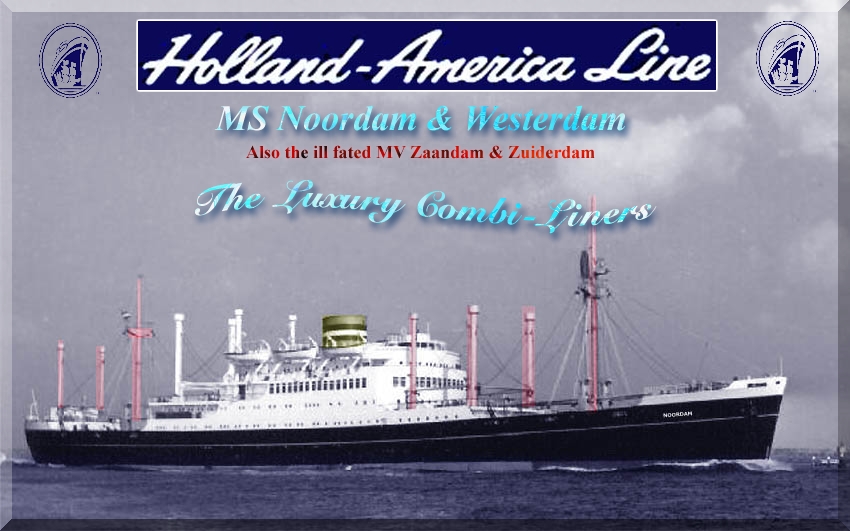
Introduction:
Holland America
Line (HAL) had considerable success with their trio of Combi-Liners, such as
the MV Dalerdijk, Delfdijk and the SS Duivendijk all having been built in
1929/30, and thus HAL decided that they would build four superior ships with
far superior and more luxurious passenger facilities!
The result was an
excellent design of a freighter hull, but with a stylish amidships
superstructure that offered four decks! These ships were perfectly balanced and
HAL employed the same interior stylists as those that were used for the great
SS Nieuw Amsterdam, thus their interiors were going to be above anything else
ever seen on any other Cargo-Passenger Liner previously! Therefore, as the MS
Noordam was the first of the four ships to be built and whilst she was in
construction, promotion was well on the way, and she was being touted as being
the “Miniature SS Nieuw Amsterdam.”
SS Noordam I:
Although the MS
Noordam was not the first HAL ship to have this name on her bow, for on
September 8, 1901 the 12,531 GRT (Gross Registered Ton) the first SS Noordam
was launched and when completed, she departed on her maiden voyage from Rotterdam to New
York on May 1, 1902. The main difference between the
first and the second Noordam being, is that the Steam Ship Noordam I was a
full-fledged Three Class Passenger Liner, but like all ships at her time, her
day serving passengers across the Atlantic was interrupted by the Great War
(WW2) and although she returned to her duties for three years after the WW1,
she was chartered for two years to Swedish North America Line and renamed
Kungsholm in 1922, then in 1924 she returned to HAL under her original name and
operated her Trans-Atlantic services. But late in 1927 she was laid up and in
May 1928 she was sold to be broken up.
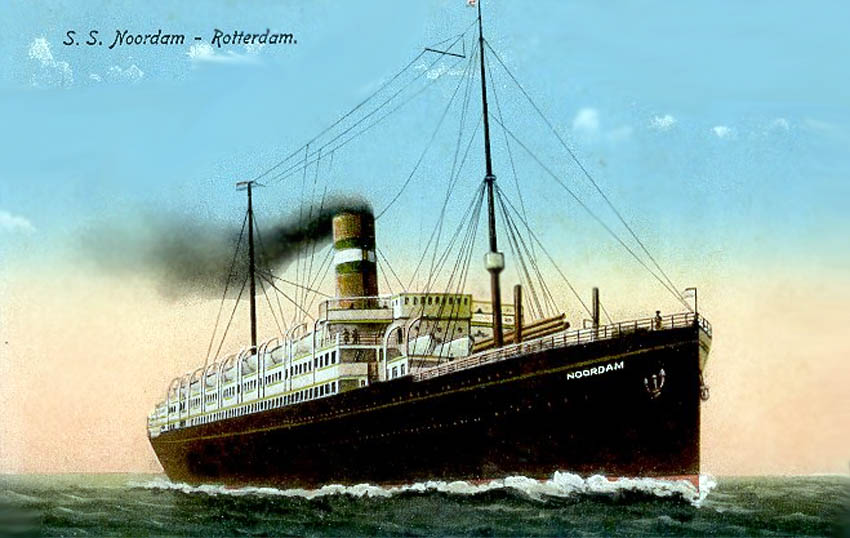
A
fine colour Holland America Line postcard of the SS Noordam I
MS Noordam II:
The Noordam was
launched in 1937 and she was completed and delivered to HAL on September 15,
1938. In Rotterdam
she was made ready for her passenger-Cargo service, thus she was manned and
fully stocked. The fully booked MS Noordam departed Rotterdam
on her Maiden Trans-Atlantic Voyage on September 28, 1938 for her nine-day
voyage to New York.
She arrived in New York Harbour on October 7, and she slowly sailed past Manhattan and all the main shipping terminals and headed
for her berth at Hoboken.
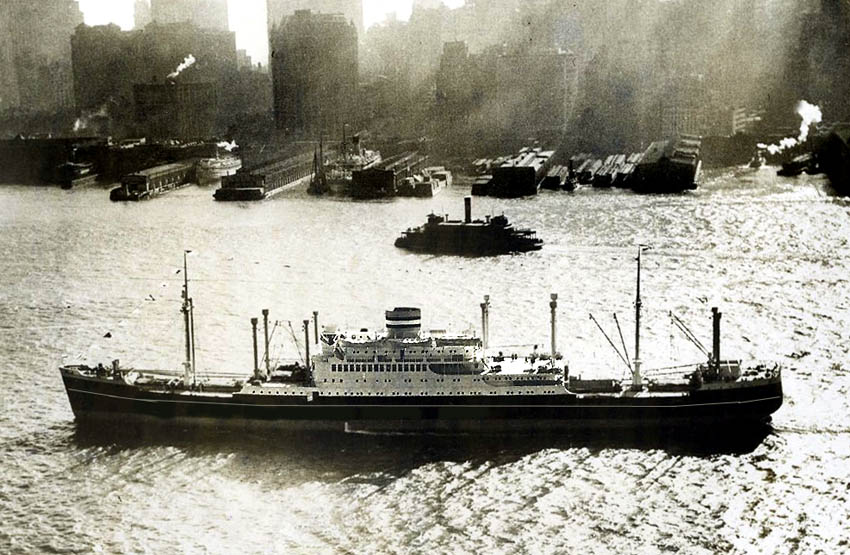
The
Noordam is seen arriving in New York
whilst on her maiden voyage on October 7, 1938
Interiors:
Ships like the
Noordam and her sister the Westerdam appealed to the wealthy passenger, who in
were general somewhat older and enjoyed a quieter way of life, but demanded
luxurious surroundings, fine food and comfortable cabin accommodations. All
cabins except one were located outside having one or two windows, and all
cabins had a private bathroom with a single or twin washbasin, WC, bathtub or a
shower. Cabins were available as a single, twin bedded and those with a third
upper Pullman,
making a twin a three-berth cabin.
The Ships Public
Venues were certainly luxurious if not sumptuous, such as the Main Lounge on
Promenade Deck that offered sheer elegance, style, luxurious comfort and an
intimate atmosphere of the kind that is simply not found on the larger and
faster passenger liners.
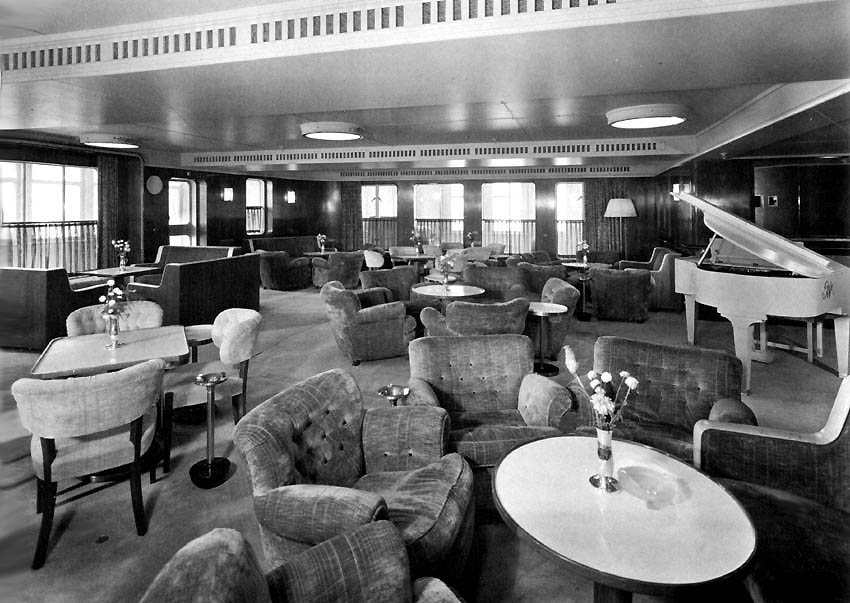
The
elegant Main Lounge
As per
usual on the ships of this type, there was little entertainment available for
there were no bands or professional musicians hired to entertain the guests, as
is done by cruise companies these days, etc. However the Lounge did have a
Grand Piano and one or more of the crew was usually an able pianist and not to
forget often several of the passengers could also play. On occasions, one of
the passengers could be an American or Dutch movie, singing star or a musician,
and at times they would delight their fellow passengers with a treat!
Of course there was
always the Gramophone in the Lounge to enjoy some music or to dance to in the
evening. On various nights a movie would be shown and these were always
welcome. Games were readily available, such as horseracing and other games,
such as the ever popular-game of cards, and the exterior deck games. Aft on
Promenade Deck was the sumptuous Smoking Room that also had a splendid Verandah
overlooking the aft deck, which had a more modern deluxe style of décor that
resembled some of the styles planned for Holland’s new largest Liner, the
Grandiose SS Nieuw Amsterdam that was only commissioned a number of months
prior to the Noordam.
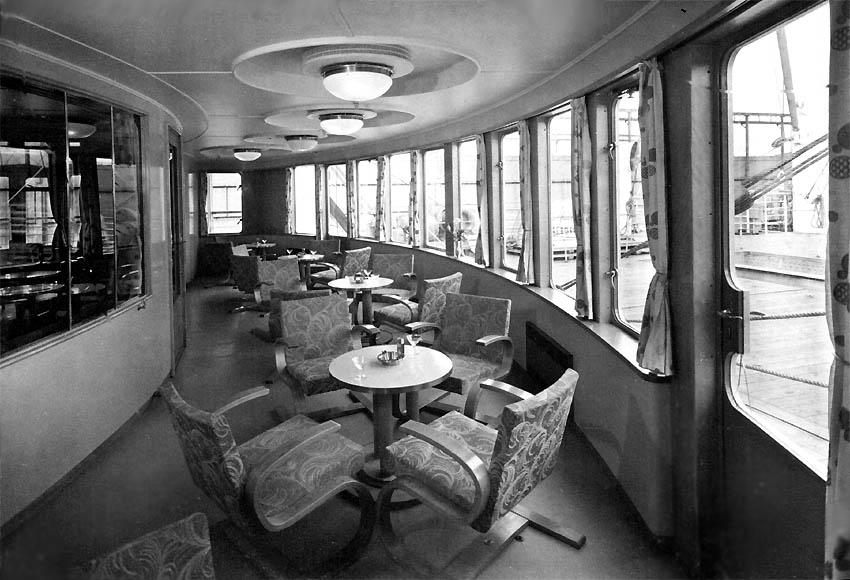
The
Smoke Room Verandah was of the more modern style compared to the rest of the
ship
The ship had a spacious Cocktail
Bar that ran along the side of Promenade Deck and like all the public venues,
this long venue also featured fine timbers along the walls and the Bar, and
ample leather finishes, making it an elegant venue, thus a room for delights
and sheer enjoyment. There was no doubt that these ships offered excellent
accommodations, with all cabins being perfectly furnished having every possible
comfort including all cabins having private facilities. All this, made these
ships “a new concept for their time.” And the Noordam and her
sister the Westerdam certainly gave HAL passengers the very best quality means
of leisurely ocean travel between Europe and the United States in their days!
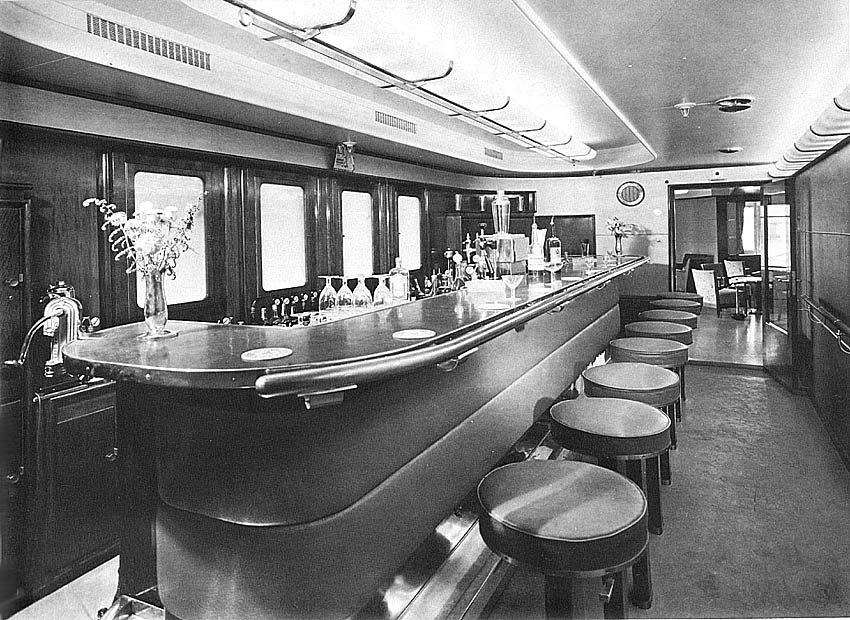
The
Ships Cocktail Bar
The MS
Noordam continued on her Trans-Atlantic service until the war commenced, but
HAL decided to take her out of harms way, thus from 1940 she was transferred to
the “Java-New York Line” to operate on the Dutch East Indies
(Indonesia) service. She departed on her first voyage to from New York to Java on March 14, 1940, this
continued until April 1942.
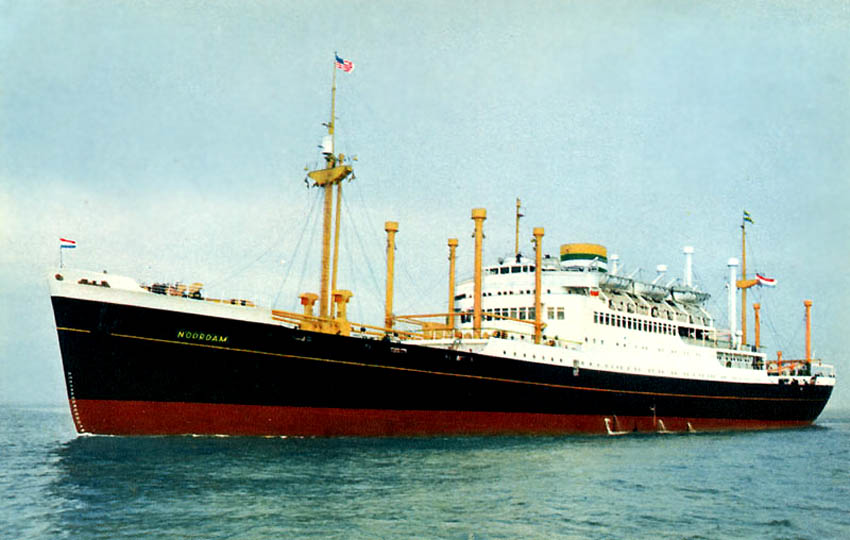
A
fine HAL postcard of the MS Noordam
War Duties:
In 1942, the MS
Noordam was converted to troopship by the Bethlehem Steel Corporation in San Francisco, with the
ship being made suitable to transport up to 2,400 troops and she was made
available to the US War Shipping Administration and sent into action and
transporting troops where needed. However, throughout her War duties, she
remained managed by HAL and the ship was always operated by a Dutch crew as
well one or two American Officer's who would be in charge of the military on
board. During the war, the Noordam transported an amazing 70,000 servicemen and
other individuals to their respective destinations.
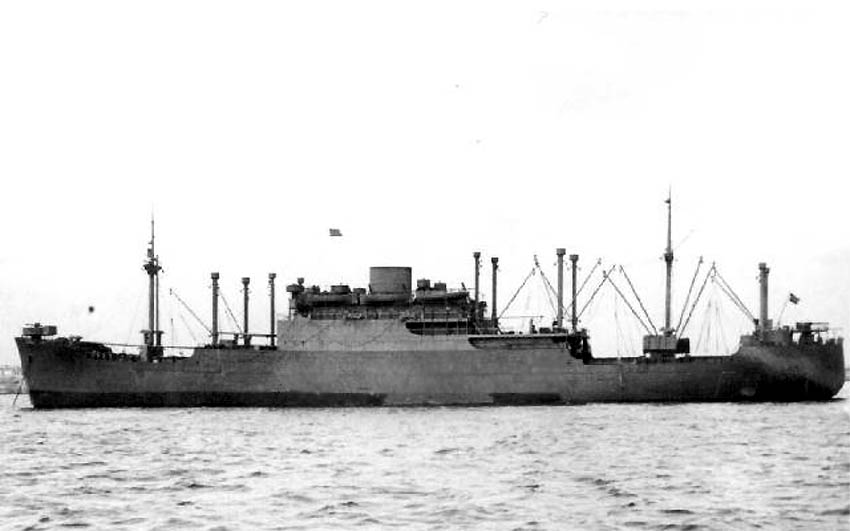
Here
wee see a very different Noordam in a war footing for the Allied forces
Photographer
unknown - *Please see the photo notes at the bottom of the page
Thankfully,
the Noordam remained completely undamaged and surprisingly came home in one
piece, unlike her two tragic sisters the Zaandam
(1939) and Zuiderdam (1940), whose story will be told a little later.
The ship received some modifications in 1944
and her Promenade Deck windows were re-installed again. However, there were big
problems in the Dutch East Indies and it was
worsening between the Dutch and the Indonesians who were now fighting for
independence. Thus on October 16, 1944
Colonel Mattheus de Bruyne
a Commander of the U.S. Marines was given the job to form the first Dutch
Marine Brigade. On November 17, 1945 Colonel Mattheus
departed on the MS Noordam from Norfolk Harbour USA, with a complement of 105 Officers and 1,939
service men and they sailed to the Dutch East Indies.
They crossed the Atlantic and headed via the Mediterranean Sea, Suez Canal and Ceylon and
finally the ship reached Indian waters. But sailing directly to Batavia was not possible, thus it was decided to head for
Port Swettenham and Penang first. Then finally
on December 30, 1945 the Noordam was able to dock in Tanjung Priok and the next day the Colonel de Bruyne
received permission to have the ship to berth in Batavia, thus they departed
and finally arrived at their destination being Batavia, today’s Jakarta.
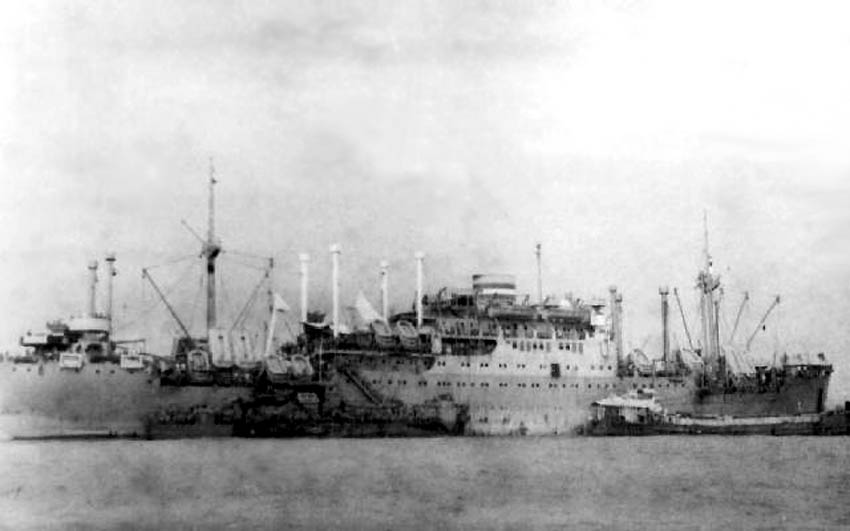
USTS
Noordam seen at anchor somewhere in the Dutch East Indies
Photographer
unknown - *Please see the photo notes at the bottom of the page
The Colonel found
that there was considerable disagreement between and the British regarding the
approach of the situation at hand with the people of Indonesia. Soekarno spread his
propaganda and wanted to independence of Dutch East Indies
no matter what!
Colonel Mattheus de Bruyne returned to
the Noordam and sailed to Singapore.
There his troops remained there until the end of February 1946 for he decided
that he would not get involved as the British were hindering the situation!
Returned to Normal
Duties:
Having returned
home in 1946 to Rotterdam
she headed to her original builders were the Noordam would receive a complete
restoration. The work that was done on her was obviously done with such great
care that she came out her refit looking very much like her original beautiful
self, the magnificent ship that was built, but with improvements. In July 1946,
the greatly loved MS Noordam was ready to return to her regular HAL
Trans-Atlantic service from Rotterdam to New York.
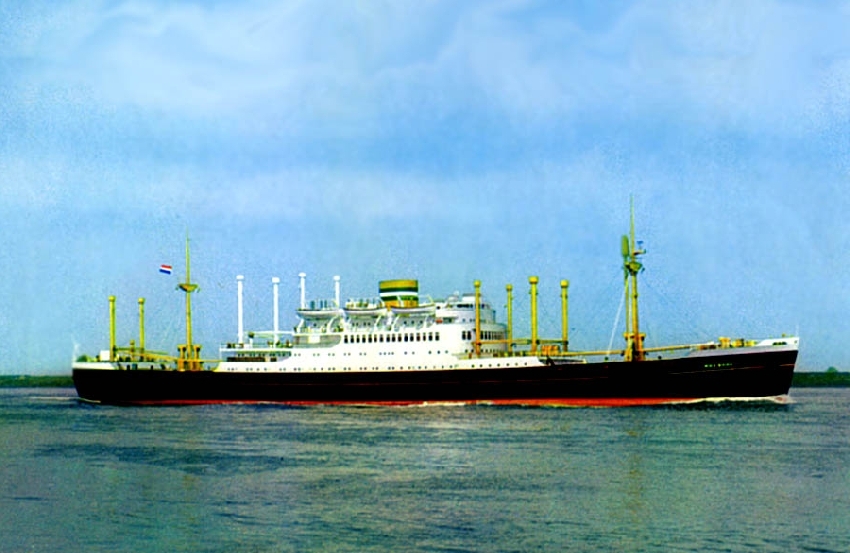
MS
Noordam is seen looking just wonderful as a Cargo-Passenger Liner once again
The MS
Noordam sailed on and continued with so many happy passengers for a further
seventeen years. However, like so many passenger and cargo ships of that time
she became caught up with what I call the; “1960’s Shipping Vs
Containerisation and Air Travel disease!” Thus the MS Noordam II was withdrawn
from duties early in 1963.
Then, on April 27,
1963 the Noordam was sold to “Cirlomar S.A.”
of Panama
being a subsidiary of Costa Line. As it turned out, she was obtained for the
sole purpose to charter her to the well-known French Shipping Company
“Messageries Maritimes.”
She was given a
refit as they required her to be a Two Class liner accommodating 106 First
Class and 96 Tourist Class passengers, when the ship was completed she was
renamed MV Oceanien. Externally the only difference were the removal of the
famed HAL gold ribbon around her hull, and all her masts and kingposts, etc
were now painted white and her funnel was a hideous painted black! Also her
tonnage was now registered as being 10,276 GRT.
The MV Oceanien
departed Marseilles on August 2, 1963 on her maiden
voyage, sailing via the Panama Canal for Papeete
- Tahiti, heading for beautiful Port Vila in the New
Hebrides and Noumea French New Caledonia.
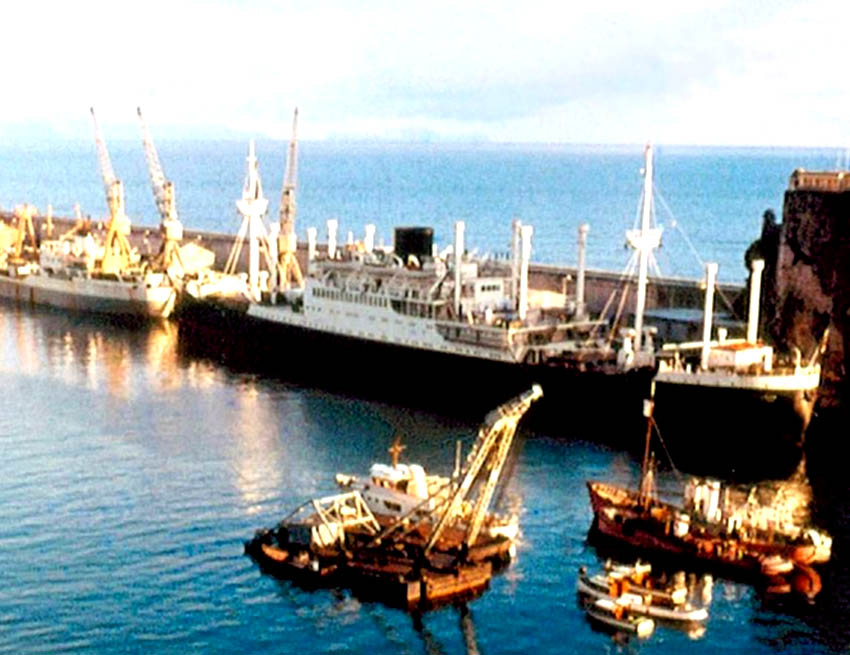
The
French France, Pacific to Australia
Liner MS Oceanien
Photographer
unknown - *Please see the photo notes at the bottom of the page
However,
on second departure from Marseilles on November
19, she operated on the same itinerary, but she continued to Sydney Australia,
arriving in Sydney
on January 9, 1964 and she departed on the 12th. This beautiful ship remained
on the Marseilles, Pacific to Australia service until her final departure from
Marseilles on March 23, 1966 and she headed for Papeete, Port Vila, Noumea
and Sydney,
where she arrived May 22. Having had her usual stay in Sydney
she departed on from Sydney on May 24, and she
headed back to Marseilles.
However, once she arrived there her charter agreement officially expired and
the ship was returned to her owner; Cirlomar S.A.
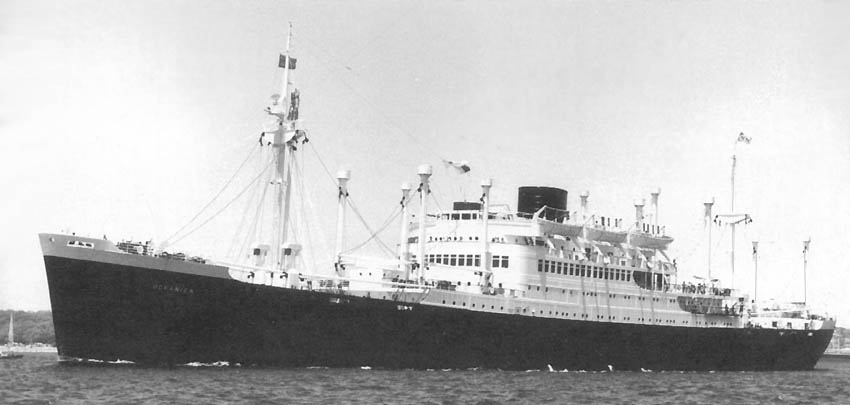
Although
her owners sought for other companies to charter her, but none was found as the
climate was just not right for she would require far too many alterations,
either to be rebuilt into a cattle carrier, or a fulltime container ship! Thus
it was decided to dispose of her and she was sold to a Yugoslav ship breaker
named “Brodospas” in December 1966, and a
little later she departed Marseilles
and sailed for Slit, arriving there on February 14, 1967 where the former MS
Noordam was demolished.
****************************
MS
Noordam Specifications:
Builder:............................................P.
Smit Jr., Rotterdam.
Yard:……………………………………………………..515.
Launched:………………………………………………April
9, 1938.
Delivered:………………………………………………September
15, 1938.
Maiden Voyage:…………………………………….September 28, 1938.
Tonnage:……………………………………………….10,704 GRT - 1946 10,726 GRT.
Length:………………………………………………….152.89m – 501.7ft.
Breadth:…………………………………………………19.62m
- 64.4ft.
Draught:………………………………………………..9.34m
- 30.7ft
Engines:…………………………………………………Burmeister
& Wain Diesels by builder.
Screws:………………………………………………….Twin Screws.
Speed:…………………………………………………..17.5
Knots.
Passengers:…………………………………………..125
- 1946 148 all First Class.
Crew:…………………………………………………….123.
****************************
MS Westerdam I:
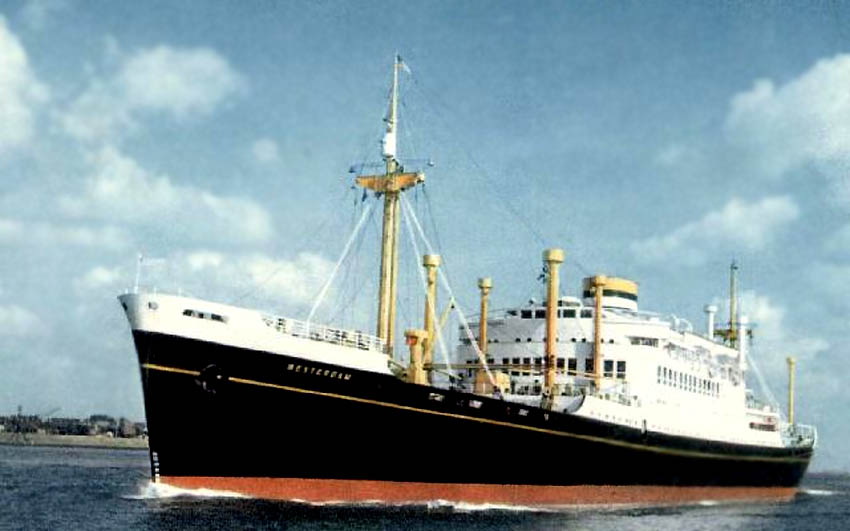
A
wonderful photograph of the MS Westerdam
The Westerdam was
in construction in a construction dock by Wilton Fijenoord at Schiedam,
Rotterdam
before the war and she was floated out (launched) on July 27, 1940 and she was
placed in lay-up. But on August 27, 1940 during an allied air raid the ships
was sunk. But the ship was seized by the Germans with the aim to complete her
as fast as possible thus they raised her. The Dutch Resistance again sank the
Westerdam in September 1944 in order that the Nazis could not use her against
the Dutch and her allies!
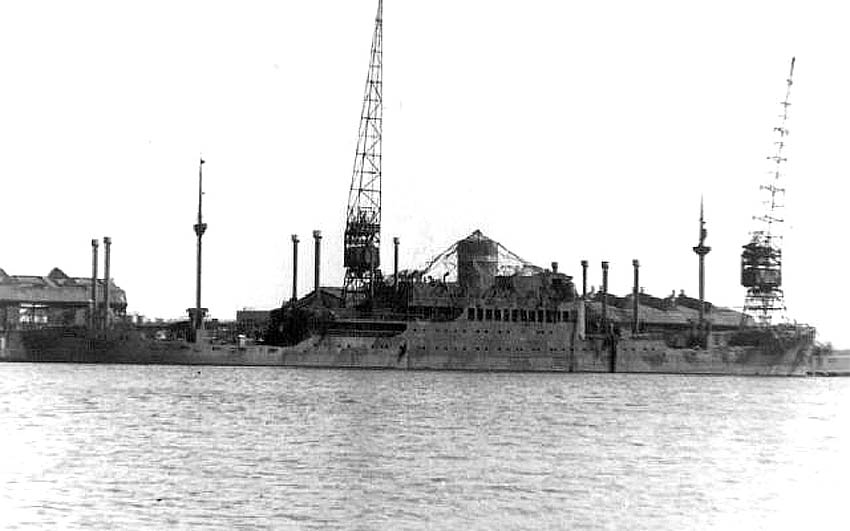
A
sad image of the MS Westerdam seen laid up in 1940
Finally, after the
War the unfinished Westerdam was refloated on September 13, 1945 and when
possible, she was taken to Wilton Fijenoord at Schiedam to be completed as was originally
intended, for the Germans had made a number of changes and these had to be
corrected. Her Interiors had to be com0letly up to the standard of the MS
Noordam including the cabins, all being located outside with windows, except on
cabin which was inside, but all cabins had private facilities with a WC,
bathtub or a shower.
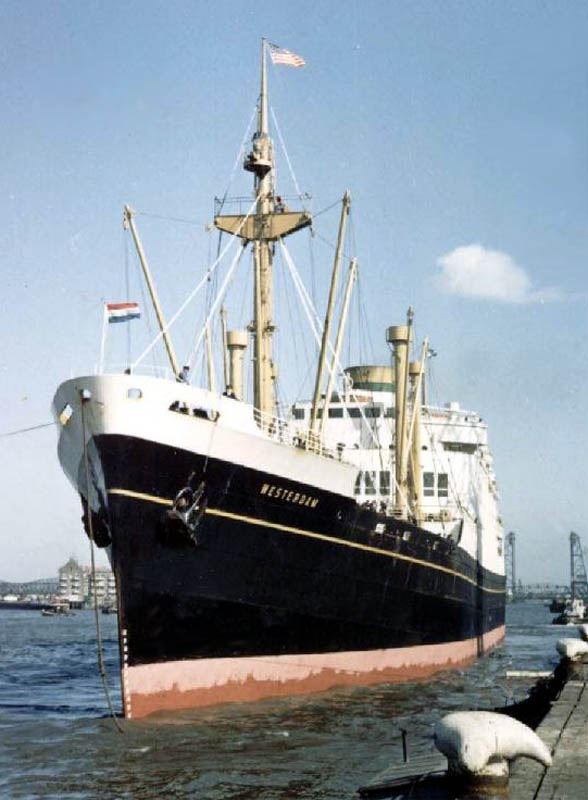
The
Westerdam is seen returning to her berth from her trails
Once this fine ship
was completed, she undertook her trails and she ran at a good 16 knots. She was
delivered to Holland America Line, just a little late, well a good six years
late, but finally on June 28, 1946 she departed with a full load of passengers
from Rotterdam for her maiden Trans-Atlantic
nine-day voyage to New York, where she like
the Noordam would be berthed at Hoboken.
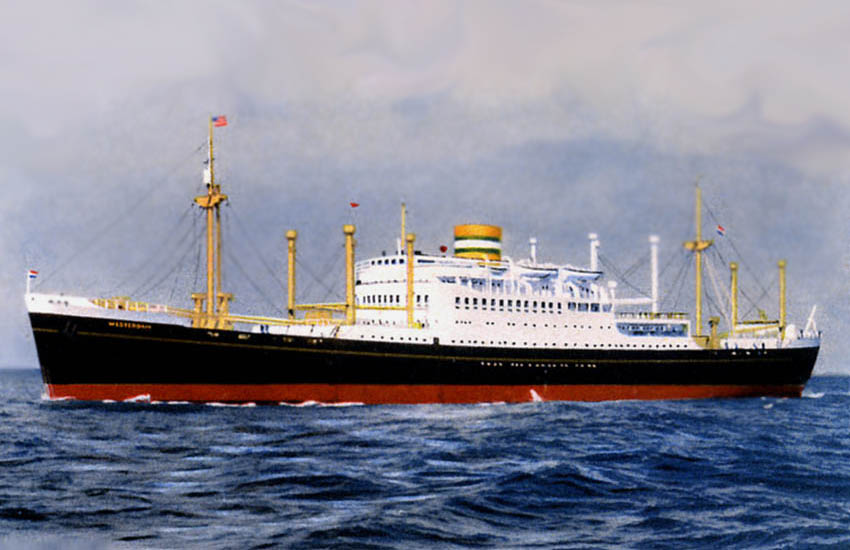
A
HAL postcard of the MS Westerdam I
The Westerdam
sailed faithfully for the HAL for a good 18 years and transported many happy
and satisfied passengers, but the time had come of that evil 1960’s
disease; being “conventional cargo-passenger shipping Vs the
Containerisation and the air travel” and for that reason HAL was forced
to lay her on November 21, 1964 in Rotterdam and placed her on the market.
She was soon sold
to a Spanish ship breaker and in 1965 the Westerdam was broken up in Alicante, Spain.
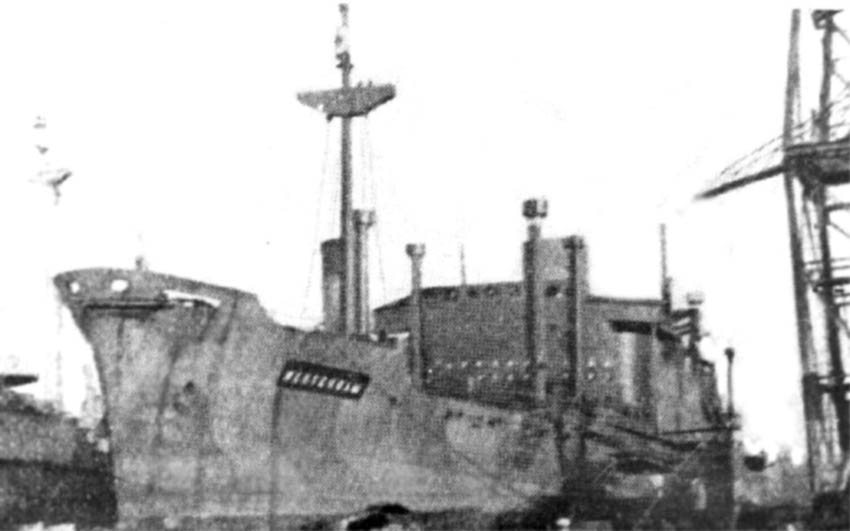
The
Westerdam at the breakers Yard
****************************
MS Westerdam Specifications:
Builder:………………………………………………….Wilton-Fijenoord,
Schiedam.
Yard:……………………………………………………..663.
Launched:………………………………………………July
27, 1940 - floated out.
Maiden Voyage:…………………………………….June 28, 1946.
Tonnage:……………………………………………….12,149 GRT.
Length:………………………………………………….157.9m – 518ft.
Breadth:………………………………………………..20.1m
- 65.9ft.
Draught:………………………………………………..9.52m
- 31.2ft.
Engines:…………………………………………………2
x M.A.N. type Diesels by builder.
Screws:………………………………………………….Twin Screws.
Speed:……………………………………………………16
Knots.
Passengers:…………………………………………..134
all First Class.
Crew:…………………………………………………….126.
****************************
The Two WWII War
Casualties:
MS Zaandam:
This ship was
originally intended to be named “Schiedam”
but it was changed to Zaandam,
being the second of the four sisters to be built. She was constructed by
Wilton-Fijenoord at Schiedam near Rotterdam and as she was
floated (launched) in her construction dock and completed on December 21, 1938.
Having been made ready and manned, she departed on her maiden voyage on January
7, 1939 from Rotterdam to New York.
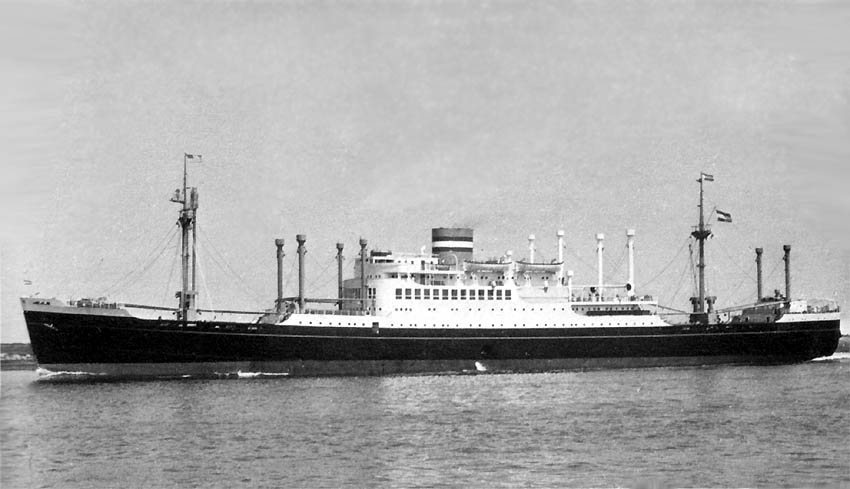
MS
Zaandam seen whilst she was on her Trans-Atlantic voyages
She operated her
Trans-Atlantic schedule for just over a year, but due to the War, she also was
transferred to the America
to Java service and she made her first voyage from New
York on April 27, bound for the Dutch East
Indies.
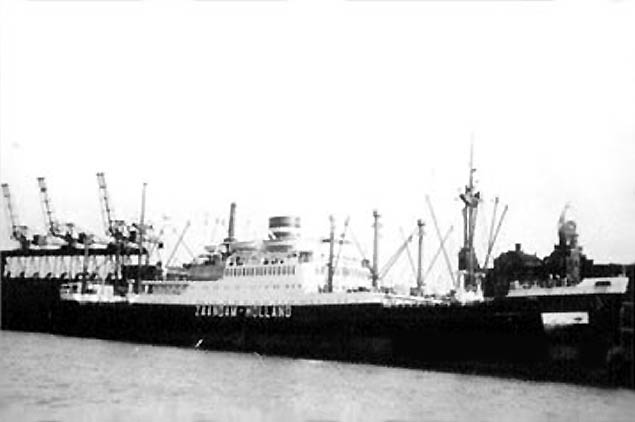
A
rare photo of the Zaandam seen in New York whilst on the
Java service
In 1942 she was
converted into a troopship and she was sent to serve the allies forces.
With the Zaandam
being in Cape Town,
she was being loaded with 8,600 ton of chrome and 600 ton of general cargo.
However boarding the ship for this voyage back to the USA were survivors of various ships that had
been sunk of the coast of Africa who were dropped off in Cape Town. British crewmen would obviously
join British ships, but the Americans were placed on MS Zaandam for the voyage
home.
The survivors of the American ships that had
been sunk by German U Boats, were from ships such as the “Chickasaw
City,” “Firethorn,” “Swiftsure,”
“Examelia” and “Coloradan” and they all boarded the MS
Zaandam on October 21, 1942 and she departed Cape Town under the command of
Captain Jacob Stamperius, with 57
Dutch crew, 1 Doctor, 33 stewards from the Dutch Indies, 18 American service
men as well as 1 each a Danish and a Swedish trainee officer, all stationed on
board and 169 passengers, thus a total complement of 299 and all headed for the USA.
But tragedy was about to strike the Zaandam, for on November 2, as she sailed into the waters
north of Brazil
the officers on duty on the Bridge were completely unaware that the enemy was
waiting. For waiting for the Zaandam was the U Boat, U-174-300 that had already
attacked and sank two other ships in the region and the Zaandam was about to be
her third victim. It would be on this day when the Zaandam
sailed about 400 miles north of Brazil
that the U-174 fired a torpedo and it hit the ship close to the engine room.
Then about nine minutes later a second torpedo slammed into the ship and
tragically she went down within just two minutes later.
From the 299 people on board that included
survivors from the other five American ships already attacked and sunk it was
horrific. One hundred and thirty people were killed in the attack and sinking
and according records, this included; 18 men from the Chickasaw City, 8 from
Firethorn, 17 from Swiftsure, 21 from Examelia and 15 from Coloradan, these
poor men suffered such an hideous event not just once, but twice and finally
gave their lives!
Two of the lifeboats containing 106 survivors
were picked up on November 7, by an American tanker the SS Gulfstate;
however two of the men who were terribly injured sadly died whilst aboard the
ship. Another lifeboat with a further 60 survivors made it to land near Barreirinhas in Brazil where again due to hardship
two of their survivors died of exposure.
As it turned out,
there were three men were unaccounted for and they were presumed lost. However,
miraculously 82 days after the Zaandam
went down, these three men that included one man from the Firethorn were picked
up by the USS PC-576. And astonishingly all three survived, being on an open
raft at sea for one of the longest periods of time in history!
Specifications:
Built in Yard 663. Engines: 2 x M.A.N. Diesels by
Builder. Propellers: 2. Speed: 18 knots. Tonnage: 10,909 GRT Length:
502ft - 152.89m. Width: 64ft - 19.62m. Draught: 31.2ft - 9.52m.
****************************
MS Zuiderdam:
Sadly the Zaandam is the only ship of the four ships to
be built that never sailed a single voyage, as she was never completed due to
the War and her fate was a rather sad one. She was to have been the last of a
fine quartet of ships to have been built, but only two really continued as
successful ships, the MS Noordam and Westerdam.
In 1941 she was floated (launched) in her
construction dock and soon after she was laid up at Schiedam
unfinished, but as the Germans had invaded, the Allied bombing began over Rotterdam and in August
28, that same year the Zuiderdam was hit during a British air raid and she
partially sank and she was tilted to port.
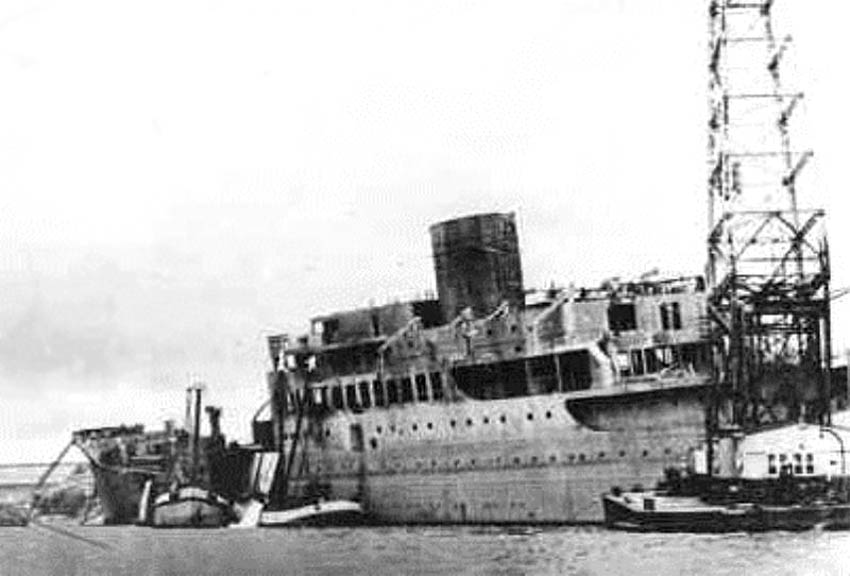
The
Zuiderdam is seen partially sunk at Schiedam
during the War
Just under a year later on July 25, 1942 she
was raised up and had the water pumped out of her and she was cleaned up and
was taken to Rotterdam
where she was laid up and she remained there until 1944.
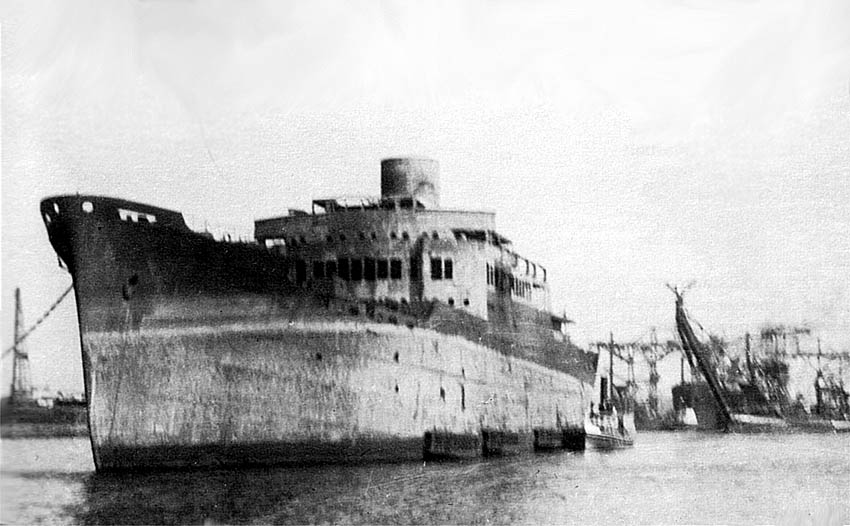
Here
we see her after she was raised again and she is now laid up in Rotterdam
However in due course she was taken to the a
place where she could be sunk in the channel where ships would sail from the
North Sea to Rotterdam, which is Called the “Nieuwe Waterweg” and
she was sunk as a blockade ship near the Maassluis
(the main lock), to stop any enemy ship entering! She was raised on November
15, 1946 and again laid up for assessment. However by 1948 it had been decided
that she was simply not worth spending a great deal of money on for the damage
was just too great. Thus she was sold to be broken up to a company in Ghent. She was taken
there undertow on June 8, 1948 and the breakers by the name of Van Heyghen Fréres broke her up in
due course.
Specifications:
Built in Yard: 672. Engines: 2 x M.A.N. Diesels by Builder. Propellers: 2.
Speed: 18 knots. Tonnage: 12,150 GRT Length: 518ft -
157.9m. Width: 65.9ft - 20.1m. Draught: 31.2ft - 9.52m.
****************************
Remembering
Two of the Finest Luxury Combi-Liners
Ever to have been Built!
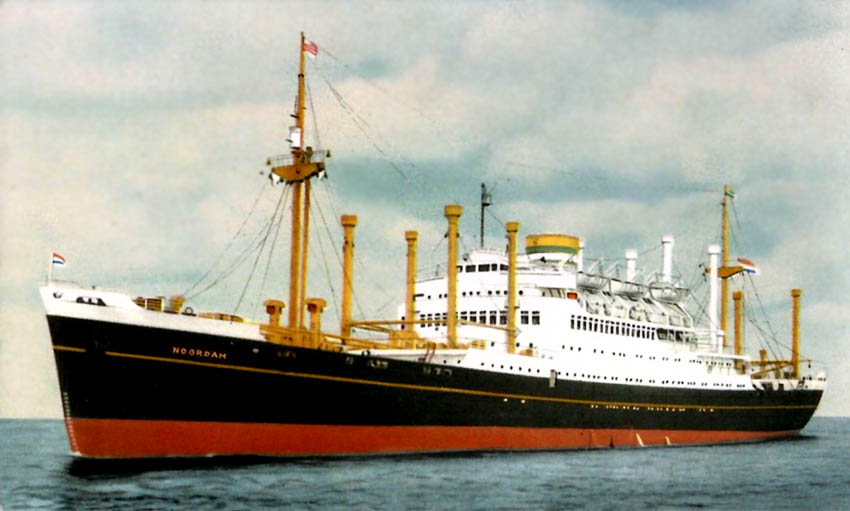
Above
& below:
The
MS Noordam and MS Westerdam they were the ultimate in perfection when it came
to Cargo-Passenger shipping!
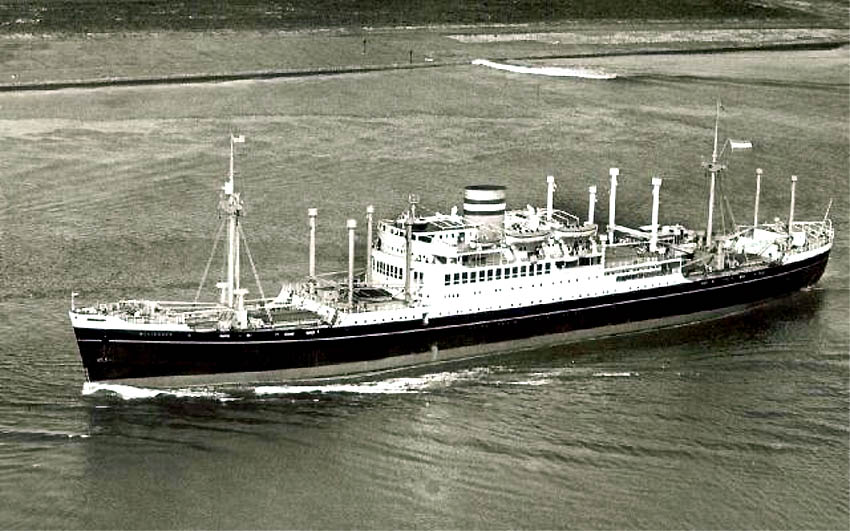
Also Visit …
M.V. Dalerdijk, M.V. Delfdijk, S.S. Duivendijk INDEX:
Page One - The Ships History & Photo Page.
Page Two - Their Deck Plans.
And
...
Feature
2 - The MS
Noordam & MS Westerdam - This Page.
Feature 3 - The SS Diemerdyk & SS Dinteldyk.
“Blue
Water Liners sailing to the distant shores.
I watched them come, I watched them go, and I watched them die.”
****************************
Visit
our ssMaritime Main INDEX
Where
you will discover more than 635 Classic Passenger & Cargo-Passenger Liners!
ssMaritime.com
& ssMaritime.net
Where
the ships of the past make history
&
the 1914 built MV Doulos Story
Also
visit my
“Save The
Classic Liners Campaign”
Please
Note: ssmaritime and associated sites are 100%
non-commercial and the author seeks no funding or
favours of any shape or form, never have and never will!
Photographs
on ssmaritime and associate pages are by the author or from the author’s
private collection. In addition there are some images that have been provided
by Shipping Companies and private photographers or collectors. Credit is given
to all contributors. However, there are some photographs provided to me without
details regarding the photographer/owner concerned. I hereby invite if owners
of these images would be so kind to make them-selves known to me (my email
address may be found on www.ssmaritime.com only), in order that due credit may be
given.
ssMaritime is
owned & © Copyright by Reuben Goossens - All Rights Reserved























